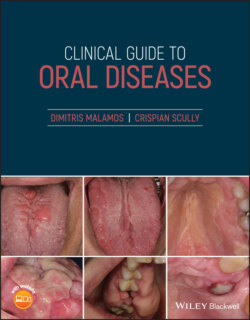Читать книгу Clinical Guide to Oral Diseases - Crispian Scully - Страница 30
Case 2.5
ОглавлениеFigure 2.5
CO: A 58‐year‐old woman presented with a dark black to blue painless swelling in the vermillion border of her lower lip, close to the right commissure.
HPC: The lesion had been present for almost 25 years, and remained unchanged. A lip trauma caused a transient increase in the size of this swelling four years ago, but day by day it returned to its previous size.
PMH: Her medical history was free of any serious diseases, except for varicose veins on her legs which were dealt with by ligation and stripping surgery two years ago. She was a non‐smoker or drinker and spent her free time gardening. She had no other similar lesions in her mouth or other parts of her body.
OE: The examination revealed a black swelling on the lower lip, approximately 5 mm in diameter, with a smooth surface but firm in palpation (Figure 2.5) which was not associated with other similar lesions within her mouth, skin, or other mucosae. Cervical lymphadenopathy was not detected. Biopsy confirmed that the lesion was vascular with amorphous calcifications at places.
Q1 What is the diagnosis?
1 Hemangioma
2 Melanoma
3 Phlebolith
4 Mucocele
5 Kaposi's sarcoma
Answers:
1 No
2 No
3 Phlebolith is the correct answer. This isolated lesion is relatively rare in the mouth of older people and is characterized by a relatively hard swelling, dark black or blue in color and associated with local vascular malformations and blood stasis causing dystrophic calcifications that are responsible for ts hard consistency.
4 No
5 No
Comments: The long but harmless course of this lesion easily allows the exclusion of aggressive neoplasms such as melanoma or Kaposi's sarcoma from the diagnosis. Hemangioma has also a similarly long course with the lesion, but appears in childhood with a tendency of being resolved over time. Mucocele sometimes has a similar color and location but is soft and fluctuant and is associated with previous trauma, but this was not reported from this lady.
Q2 Which is the most common dystrophic calcification, apart from phleboliths, in the head and neck region?
1 Myositis ossificans
2 Calcified epidermal cysts
3 Calcified lymph nodes
4 Calcified acne
5 Osteitis deformans
Answers:
1 No
2 No
3 Calcified lymph nodes are numerous small masses of calcification within the lymph nodes of the head and neck region due to chronic inflammation, infection, or neoplasia.
4 No
5 No
Comments: The other diseases causes dystrophic calcifications in the head and neck region but their calcifications are rare and accompanied with lesions in jaws and other bones (osteitis deformans); the facial muscles (myositis ossificans), in the healing acne vulgaris lesions (calcinosis cutis) and within epidermal cysts.
Q3 Which is or/are the difference/s between a small phlebolith and salivary gland stone?
1 LocationSymptomatologyAge of appearanceCompositionRadiological features
2 Answers:The calculus in the phlebolith is located within a vein while the sialolith is located within salivary gland or its duct respectively.Small phleboliths do not cause severe symptoms apart from esthetic problems, while sialoliths are associated with salivary gland enlargement, topical inflammation and pain.Phleboliths are “vein stones” and are presented in younger patients with vascular malformations, but sialoliths appear in older patients.Phleboliths are calcified thrombus of calcium carbonate and phosphorus within a dilated vessel, while sialoliths consist of a mixture of hydroxyapatite and carbonate‐apatite, centrally, being surrounded by an organic component of glycoproteins, mucopolysaccharides, lipids and cell dendrites.Radiographically, phleboliths are presented as oval or round radiopacities with a radiolucent center while sialoliths are elongated following a ductal shape.
